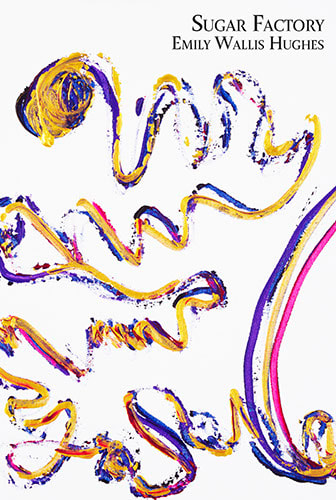|
Sugar Factory by Emily Wallis Hughes (Spuyten Duyvil, 2019)
Your rhythm will delete all of your past (from “Day”) The way we interpret the world through the act of creativity, as a form of release. A form of bliss. A form of transformation. The way we receive the world and volley it backward, toward a new target, through a new direction. The relationships between artist and artistry, conversion and translation, object and worldview The poet and the poetry as the contemporary medium for the facilitated conversation the profound thirst for an achieved, beloved existence. The painter as the meditator before the walls of the imagined essence, the exasperation of a beautified interpretation. The conceptual framework of conceiving the longitude of the sugar factory captured in geometric space. The record of friendship. Spellbinding consistency of communication and the microcosmic resound of community. And how the book forms forward these enticements. Sugar Factory is a collaborative project between New York writers/artists Emily Wallis Hughes (who has provided the literary text) and Sarah Riggs (who has provided the cover and interior artworks, images originally created by way of Lascaux paints and followed Hughes's poetry). The book contains 63 works (poems and visual art) and concludes with an uplifting and resolute essay on the autobiographical roots of the generative qualities of the works and the act of publishing as collaboration. The book, the first book of poetry by Hughes, is a joyride of canvas wrapped into new canvas, palette stacked upon palette, range of knowing exquisitely exposed before other knowing. Sugar Factory is a delightful romp between the communicated selves of two alive and intimate individuals. On an opened jean jacket I lay our triplets out nude in the Poland snow which exists within the narrow margin we see surrounding dawn (from “Church Bells Come From the East”) Reading Sugar Factory, I find myself pushed through text as though it is the current along a rocky coastline. The energies are subtle, often invisible, yet bright and present and full and cavernous. What exists above, through, and beneath the experience of reading these poems? I think, as I take hold, and push in, dive in, explore. The poems are phantasmagorical and spontaneously spirited. They are chopped up moments that lead in and out of the everyday experience. They are chopped up instances of significance. There is reflection of the mutually beneficial: the feedback of a world that is at one outside and untouchable as well as within and universal. I am reminded of the haunts of an older world, of a world that is far less abstracted, far less buried, far more present, far more accessible. The elusive image, the Sugar Factory itself, a nothing-place filled with the nothing that is life, experience, and contentment. The air, pressing all acute Still, though, the sky is a good idea (from “The Sky”) Hughes represents the autonomous, creative human throughout the book. Her exposures to the decision-making process that underly all creative works, including those that are often so large they loom, including books like Sugar Factory, offers reverence, consolation, and maturity. The effect feels respectful toward the reader who is otherwise along for the ride, spoon-fed spoonfuls of image and quirk, expression and invocation. The musings and reflections that make up what is a long sequence of memento and record-keeping are powerful pressures toward keeping the structure of the work in place. Often this structure is one empowered and uplifted through a sense of mystery. Why are some decisions made? What does exposition leave out? Is there more the reader must understand, or is the entire world a blur? And, of course, there are questions about the nature of the collaboration and the placement of Riggs’s paintings, which add their own effect of the canny and uncanny alike: drips and spurts and splashes of creamy, oily, bold color that comforts and rockets one and the same. She starts making a basket out of Yerba Buena and out of her own hair and her sister’s hair and out of out of dog blood and out of the elderberries dropped on the gravel path to her best friend’s house She, she forgets I forget how (from “Day”) A sense of bewitching and ritualization is another quality I enjoyed encountering through Sugar Factory. With qualities of ambiguity and fragmentation that exist within the sequence of poems overall, down to the smaller details that remain flashes of inspiration and evocative momentary genius, the book feels utterly alive and beyond reach. The moments, such as the one quoted from above in “Day,” represent a much more cohesive arrangement of objects and actions that feels intentionally experiential. Whether these utterances and descriptions are actual rituals or serve a higher degree of personhood and liveliness is unspoken and is as uncertain as the book as a whole; and yet they offer counterbalance/counterpoint to the otherwise fullness of the currents of energy that move from one moment of Sugar Factory to the next. They sit supportively providing a sense of center to that ongoing, fantastical mystery awakened through the efforts of Hughes and Riggs, jointly combined into a common space. She speaks, says after loss there is always beauty. Then loss again beauty again loss ever youth over the daffodil death under the milkmaids. (from “Three Women”) Overall, the book is a flighty, fascinating space that rounds itself out in the connection between two creative individuals who have released into the world an organized smattering of chaos. It’s fun and enjoyable to read, intellectually enveloping, and distinctly arranged through the joy of cooperative activity. It serves as euphoric juxtaposition: preview to the personal and pull upward toward the global collection of experience.
0 Comments
Your comment will be posted after it is approved.
Leave a Reply. |
Welcome to Yellow Rabbits. Thanks for visiting.
All reviews by Greg Bem unless marked otherwise.
SearchYellow Rabbits Reviews
Archives by Month
August 2019
|

